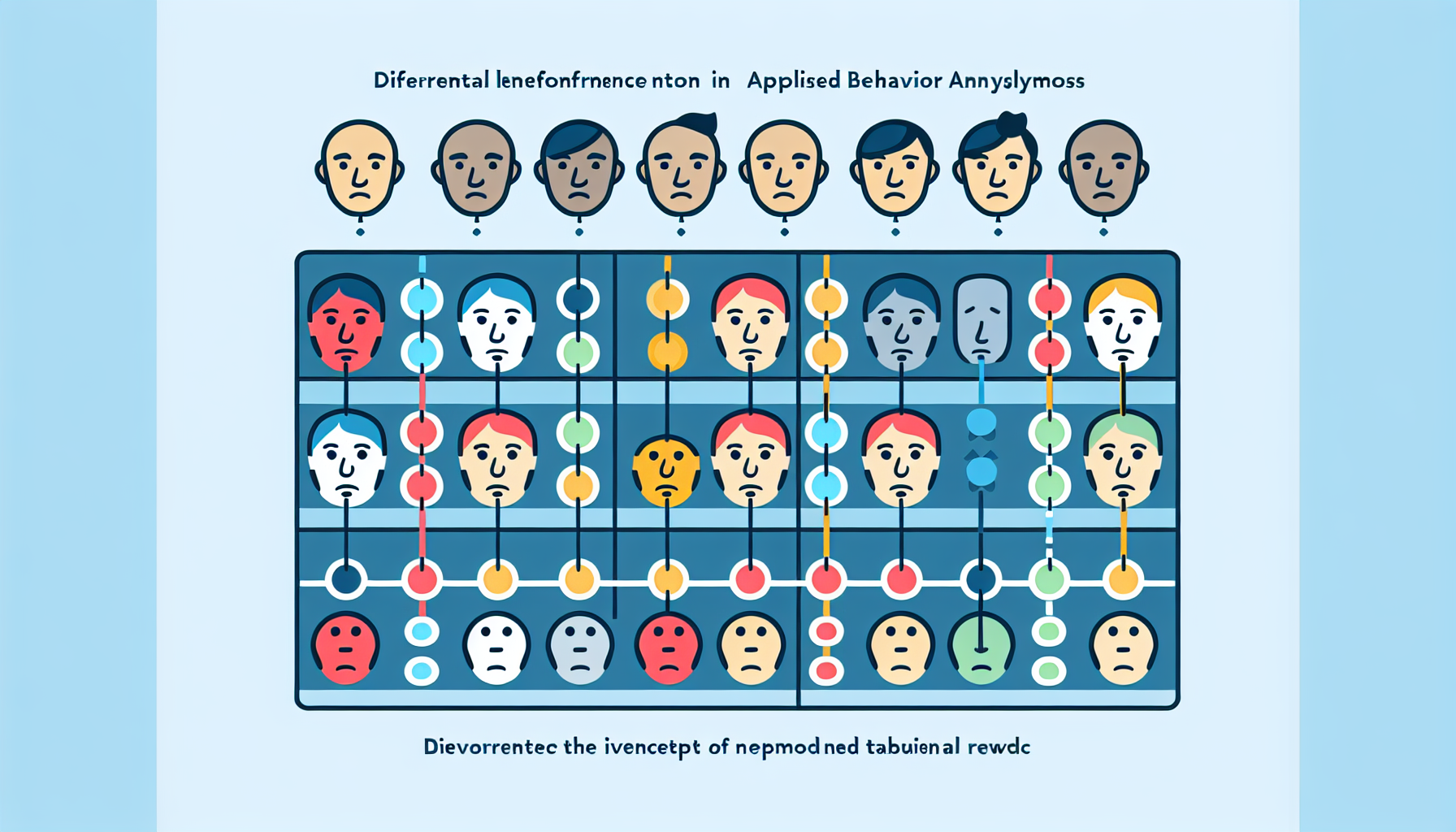Understanding Differential Reinforcement
In the field of Applied Behavior Analysis (ABA), differential reinforcement is a behavior modification technique used to increase the frequency of desired behaviors while withholding reinforcement for undesired or challenging behaviors. It involves selectively reinforcing specific, positive actions to encourage their repetition, while minimizing or eliminating reinforcement for less appropriate responses.
This approach is commonly applied in educational, clinical, and home settings to help shape behavior over time. By understanding the fundamentals of differential reinforcement and the different strategies involved, such as DRI, DRO, and DRA, practitioners can design more effective interventions that support meaningful and lasting behavior change.
Basics of Differential Reinforcement
The basic principle of differential reinforcement is to provide reinforcement or consequences based on the presence or absence of specific target behaviors. By reinforcing desired behaviors and withholding reinforcement for undesired behaviors, individuals learn to associate positive outcomes with the desired behaviors, leading to behavior change.
Differential reinforcement can be employed in various settings, including schools, homes, and therapy sessions. It is often used to address behavioral challenges in individuals with autism spectrum disorder (ASD) or other developmental disabilities, but it can be applied to individuals of all ages and abilities.
Types of Reinforcement Strategies
There are several types of differential reinforcement strategies used in behavior modification. Three common techniques are:
- Differential Reinforcement of Alternative Behavior (DRA): DRA involves reinforcing a desirable alternative behavior while withholding reinforcement for an undesirable behavior. This strategy focuses on promoting the occurrence of a specific alternative behavior that serves as a substitute for the problem behavior. For example, a child who engages in disruptive behavior may be reinforced for using appropriate communication skills instead.
- Differential Reinforcement of Incompatible Behavior (DRI): DRI aims to decrease problem behavior by reinforcing a behavior that is incompatible with the targeted behavior, while withholding reinforcement for instances of the problem behavior. Incompatible behaviors cannot occur simultaneously with the problem behavior. For instance, a child who struggles with walking around the room may be reinforced for sitting in a seat.
- Differential Reinforcement of Other Behavior (DRO): DRO involves withholding reinforcement for problem behavior and providing reinforcement for any other behavior within a specified time period. This strategy is particularly useful when it is challenging to identify or teach an appropriate replacement behavior. By reinforcing any behavior other than the problem behavior, individuals are encouraged to engage in alternative activities or behaviors.
Understanding these different types of reinforcement strategies allows behavior analysts and caregivers to tailor interventions to the specific needs and goals of individuals. By implementing the appropriate technique, they can effectively shape behavior and promote positive change.
In the subsequent sections, we will explore how these differential reinforcement techniques are applied in behavior modification, strategies for their effective implementation, and the advantages and limitations of using differential reinforcement in Applied Behavior Analysis (ABA) practices.
Differential Reinforcement in Behavior Modification
Differential reinforcement is a technique used in behavior modification to increase the occurrence of desirable behaviors while reducing or eliminating unwanted behaviors. It involves providing reinforcement or consequences based on the presence or absence of specific target behaviors. This section will explore the concepts of positive and negative reinforcement and the application of differential reinforcement in various settings.
Positive and Negative Reinforcement
In the context of differential reinforcement, positive and negative reinforcement refer to different types of consequences that can be used to reinforce or strengthen behaviors.
Positive reinforcement involves providing a desirable stimulus or reward following the occurrence of a target behavior. This increases the likelihood of that behavior occurring again in the future. For example, a teacher may provide praise or stickers to students who complete their assignments on time, which reinforces the desired behavior of timely completion.
Negative reinforcement, on the other hand, involves the removal or avoidance of an aversive stimulus following the occurrence of a target behavior. This also increases the likelihood of that behavior happening again. An example of negative reinforcement is a parent removing a chore from a child’s list once they finish their homework on time.
Both positive and negative reinforcement can be effective in modifying behavior when used appropriately and consistently. The choice between positive and negative reinforcement depends on the individual and the specific circumstances.
Application in Various Settings
Differential reinforcement can be applied in various settings, including education, parenting, the workplace, and the treatment of conditions such as Autism Spectrum Disorder (ASD) and Attention Deficit Hyperactivity Disorder (ADHD). Its versatility makes it valuable in promoting positive behavior change across different contexts.
In educational settings, teachers can use differential reinforcement techniques to reinforce desired behaviors, such as active participation, following rules, and completing assignments. By providing positive reinforcement for these behaviors, educators can create a conducive learning environment and encourage students to engage in appropriate conduct.
In parenting, differential reinforcement can be applied to shape desirable behaviors in children. By consistently reinforcing positive behaviors, parents can encourage good manners, household chores, and academic achievements. Likewise, they can use negative reinforcement by removing or reducing unpleasant consequences when children exhibit appropriate behaviors.
Differential reinforcement is also relevant in the workplace, where it can be used to reinforce desired employee behaviors, such as meeting deadlines, collaborating effectively, and displaying professionalism. Employers can implement positive reinforcement strategies, such as recognition programs or performance-based incentives, to motivate employees and improve productivity.
Furthermore, differential reinforcement techniques play a significant role in the treatment of conditions like Autism Spectrum Disorder (ASD) and Attention Deficit Hyperactivity Disorder (ADHD). By reinforcing socially appropriate behaviors and reducing undesirable ones, individuals with these conditions can learn and develop adaptive skills, improving their overall quality of life.
In summary, differential reinforcement is a valuable behavior modification technique that can be applied in various settings. By utilizing positive and negative reinforcement strategies, individuals can effectively shape behaviors, promote positive change, and create a supportive environment for growth and development.
Differential Reinforcement Techniques
When it comes to behavior modification, differential reinforcement techniques play a significant role in promoting positive change. These techniques involve reinforcing specific behaviors while withholding reinforcement for others. Here, we will explore three commonly used differential reinforcement techniques: Differential Reinforcement of Alternative Behavior (DRA), Differential Reinforcement of Incompatible Behavior (DRI), and Differential Reinforcement of Other Behavior (DRO).
Differential Reinforcement of Alternative Behavior (DRA)
Differential Reinforcement of Alternative Behavior (DRA) is a behavior modification technique that focuses on reinforcing a desirable alternative behavior while withholding reinforcement for an undesirable behavior. The alternative behavior should serve the same function as the problem behavior.
For example, if a child engages in disruptive attention-seeking behaviors, such as calling out in class, the DRA approach would involve reinforcing the child when they raise their hand to ask for attention instead. By providing positive reinforcement for the desired behavior, the goal is to replace the problem behavior with a more appropriate alternative.
Differential Reinforcement of Incompatible Behavior (DRI)
Differential Reinforcement of Incompatible Behavior (DRI) is another effective technique used in behavior modification. In DRI, the focus is on identifying a behavior that is incompatible with the problem behavior and reinforcing it when it occurs, while withholding reinforcement for the problem behavior.
Let’s consider an example where a child exhibits aggressive behaviors, such as hitting others. In this case, a suitable replacement behavior that is incompatible with hitting, such as using words to express frustration, would be reinforced. By reinforcing the incompatible behavior, the child learns alternative ways of expressing themselves, leading to a reduction in the problem behavior.
Differential Reinforcement of Other Behavior (DRO)
Differential Reinforcement of Other Behavior (DRO) involves reinforcing the absence of a problem behavior for a specific period of time, while withholding reinforcement for the problem behavior itself. This technique is particularly useful when it is challenging to identify or teach an appropriate replacement behavior.
For instance, if a child engages in constant whining, a DRO approach may involve reinforcing periods of time when the child refrains from whining. By providing reinforcement for the absence of the problem behavior, the child learns that alternative behaviors are more effective in obtaining desired outcomes.
Each of these differential reinforcement techniques has its own unique advantages and considerations. The selection of the most appropriate technique depends on the specific behavior being addressed and the individual’s needs. By implementing these techniques effectively, behavior analysts and practitioners can make a positive impact on individuals’ lives and promote meaningful behavior change.
Implementing Differential Reinforcement
To effectively implement differential reinforcement, it is important to consider certain strategies and be aware of potential considerations and challenges.
Strategies for Effective Implementation
- Clear Communication: When implementing differential reinforcement, it may be beneficial to inform the individual or individuals explicitly about the new plan. This ensures transparency and clarity. By explaining the reinforcement contingencies and the desired target behaviors, you can help set clear expectations and increase the likelihood of success.
- Consistency: Consistency is key when implementing differential reinforcement. It is crucial to consistently reinforce the desired target behaviors while withholding reinforcement for inappropriate or unwanted behaviors. This helps to establish a clear connection between behavior and consequences, allowing for more effective behavior modification.
- Data Collection and Analysis: Keep track of the target behaviors and the corresponding reinforcement provided. Collecting data allows for objective measurement and analysis of progress. It helps to identify patterns, make informed decisions, and adjust reinforcement strategies if necessary. Data collection can be done through various methods, such as direct observation, behavior charts, or digital tracking tools.
- Individualization: Differential reinforcement techniques should be tailored to the individual’s specific needs and preferences. What works for one person may not be as effective for another. Take into account factors such as age, developmental stage, cultural background, and personal interests when designing and implementing reinforcement strategies.
Considerations and Challenges
- Behavioral Assessment: Conducting a thorough behavioral assessment is crucial before implementing differential reinforcement. Understanding the function or purpose of the target behavior and identifying any underlying factors that may contribute to its occurrence is essential. This assessment helps in selecting the appropriate reinforcement strategy and ensuring its effectiveness.
- Selectivity of Reinforcement: Choosing the appropriate reinforcement is essential for successful implementation. Reinforcers should be meaningful and desirable to the individual. What is reinforcing for one person may not be reinforcing for another. It may be necessary to conduct preference assessments to identify the most effective reinforcers for each individual.
- Generalization: Generalizing the desired target behaviors across different settings, people, and situations can be a challenge. Reinforcement strategies should be implemented consistently across various environments to promote generalization. Providing opportunities for practice and reinforcement in different contexts helps individuals transfer the desired behaviors to real-life situations.
- Monitoring and Maintenance: Continuous monitoring and evaluation of the differential reinforcement program are essential. Regularly reviewing progress, making adjustments as needed, and ensuring consistency in the application of reinforcement are crucial for long-term success. Behavioral interventions should be viewed as an ongoing process rather than a one-time fix.
Implementing differential reinforcement requires careful planning, consistent application, and ongoing evaluation. By employing effective strategies and addressing potential considerations and challenges, differential reinforcement can be a powerful tool in behavior modification, promoting positive behavior change and improving the lives of individuals.
Differential Reinforcement in Applied Behavior Analysis (ABA)
Differential reinforcement plays a crucial role in Applied Behavior Analysis (ABA) practices. ABA is a behavior modification approach that focuses on understanding and changing behaviors through systematic interventions. Differential reinforcement is a technique used within ABA to selectively reinforce desired behaviors while withholding reinforcement for undesired behaviors.
Importance in ABA Practices
Differential reinforcement is widely used in various settings where behavior modification is necessary. It has proven to be effective in education, parenting, the workplace, and the treatment of Autism Spectrum Disorder (ASD) and Attention Deficit Hyperactivity Disorder (ADHD). By employing differential reinforcement techniques, professionals can create meaningful changes in behavior and promote the development of adaptive skills.
The goal of using differential reinforcement in ABA practices is to increase the occurrence of desired behaviors while decreasing or eliminating unwanted behaviors. It provides individuals with clear expectations and appropriate consequences for their actions, helping them acquire and maintain socially acceptable behaviors.
Success Stories and Case Studies
Numerous success stories and case studies highlight the effectiveness of differential reinforcement in ABA. Here are a few examples:
- Reduction of Problem Behaviors: In a study published in Research in Developmental Disabilities, differential reinforcement procedures, including DRI, DRA, and DRO, were found to be effective in reducing problem behaviors in adults with intellectual disabilities. These procedures provided less intrusive methods without aversive stimuli or punishment contingencies.
- Intervention for Classroom Behavior: ScienceDirect reports the use of differential reinforcement of incompatible behavior (DRI) to address a child’s continuous out-of-seat behavior in the classroom. By systematically reinforcing the child for remaining seated, the problem behavior of leaving the seat was reduced.
- Treatment of Chronic Skin-Picking: In the treatment of chronic skin-picking in individuals with developmental disabilities, differential reinforcement of incompatible behavior (DRI) has been effective. By placing the target behavior on extinction and reinforcing a behavior that is incompatible with skin-picking, positive changes in behavior have been observed.
These success stories illustrate the practical application and positive outcomes of differential reinforcement in ABA practices. By tailoring reinforcement strategies to specific behaviors and individuals, professionals can make significant improvements in behavior and overall quality of life.
Differential reinforcement serves as a cornerstone within ABA, offering effective tools for behavior modification and promoting the growth of adaptive behaviors. Through its implementation, individuals can learn new skills, reduce problem behaviors, and achieve greater independence and well-being.
Advantages and Limitations of Differential Reinforcement
Differential Reinforcement (DR) offers several distinct advantages over traditional reinforcement methods in the context of behavior modification. However, it is important to consider the potential drawbacks and considerations associated with its implementation.
Benefits of Differential Reinforcement
- Positive Approach: Differential reinforcement focuses on reinforcing desired behaviors rather than punishing or suppressing unwanted behaviors. This positive approach creates a supportive and encouraging environment for behavior change, promoting a sense of accomplishment and self-esteem.
- Wide Applicability: Differential reinforcement strategies can address a broad range of behaviors, making them versatile in behavior modification. Whether it is reducing problem behaviors in individuals with intellectual disabilities (Research in Developmental Disabilities) or managing behavior problems in adults with intellectual disabilities (Research in Developmental Disabilities), DR techniques have been found to be effective in various populations.
- Non-Aversive: Differential reinforcement procedures, such as Differential Reinforcement of Incompatible Behavior (DRI), do not involve aversive stimuli or punishment contingencies. This non-aversive nature ensures a more humane and ethical approach to behavior change.
- Effectiveness in Reducing Problem Behaviors: Differential reinforcement procedures have demonstrated effectiveness in reducing problem behaviors. For example, DRI has been successfully used to decrease problem behaviors in individuals with dementia, such as physically aggressive behavior, throwing objects, smearing feces, and disrobing in front of visitors.
Potential Drawbacks and Considerations
- Careful Selection and Monitoring: The success of differential reinforcement relies on careful selection and monitoring of reinforcement. It is essential to identify appropriate reinforcers and ensure consistency in their delivery. Inadequate reinforcement or inconsistency can undermine the effectiveness of the technique.
- Generalization and Maintenance: It may be challenging for individuals to generalize the learned behaviors from the specific settings where differential reinforcement is implemented to other contexts. Additionally, maintaining the desired behaviors over time can be a concern, requiring ongoing support and reinforcement [4].
- Individual Variability: The effectiveness of differential reinforcement can vary depending on individual differences. Factors such as age, cognitive abilities, and motivation can influence the response to reinforcement strategies. Flexibility and individualization of the approach may be necessary to ensure optimal outcomes.
- Time and Resource Intensive: Proper implementation of differential reinforcement strategies requires time, effort, and resources. It involves careful assessment, planning, and ongoing monitoring of behavior and reinforcement. Professionals involved in behavior modification programs need to be adequately trained and dedicated to ensure successful implementation.
Understanding the advantages and limitations of differential reinforcement is crucial when considering its application in behavior modification. While it offers numerous benefits, careful consideration of the potential challenges and individual factors is essential for successful outcomes. By leveraging the strengths and addressing the limitations, differential reinforcement can be an effective tool in promoting positive behavior change.
References
- https://www.nu.edu/blog/what-is-differential-reinforcement/
- https://difflearn.com/blogs/http-blog-difflearn-com/differential-reinforcement-of-incompatible-behavior
- https://ebip.vkcsites.org/differential-reinforcement/
- https://www.adinaaba.com/post/differential-reinforcement-in-aba
- https://www.sciencedirect.com/science/article/pii/S0891422211000238
- https://www.sciencedirect.com/topics/psychology/differential-reinforcement-of-incompatible-behavior
- https://www.sciencedirect.com/science/article/pii/S0891422210003476




